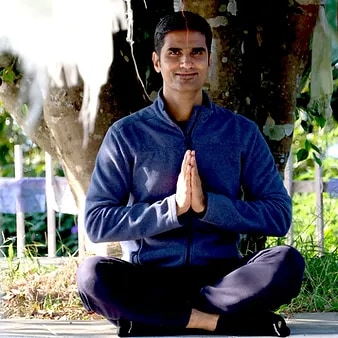the power of mantras in yoga -
A Harmonious Journey Within
by Hardik Mehta

Yoga, an ancient practice that harmonizes the body, mind, and soul, has become a global phenomenon, cherished for its comprehensive approach to well-being. Among its many components, one element stands out as a powerful tool for transformation and inner peace: Mantras. These sacred sounds or phrases have been an integral part of yoga for centuries, and their potency is undeniable. In this blog, we will explore the profound influence of mantras in yoga, delving into their history, significance, and the transformative power they hold for practitioners.
The Roots of Mantras in Yoga
To understand the power of mantras in yoga, we must first journey back in time to the origins of this ancient practice. Yoga, which means “union” in Sanskrit, has its roots in the Indian subcontinent, dating back over 5,000 years. Its purpose is to create harmony between the individual and the universe, fostering physical, mental, and spiritual well-being.
Mantras, also rooted in Sanskrit, are sacred sounds, syllables, or words that are believed to possess profound spiritual and vibrational qualities. They have been used for millennia in various spiritual and religious traditions, including Hinduism, Buddhism, and Jainism. In yoga, mantras play a significant role in achieving the ultimate union of the self with the divine.
The Significance of Mantras in Yoga
- Focusing the Mind
One of the primary challenges in yoga is quieting the mind. The continuous stream of thoughts can be distracting and hinder the practitioner’s ability to achieve a state of deep meditation or concentration. Mantras provide a powerful solution by giving the mind a single point of focus. Chanting or repeating a mantra allows the practitioner to direct their mental energy toward a specific sound or vibration, helping to still the mental chatter and attain a state of inner calm. - Raising Vibrational Energy
Mantras are believed to carry a unique vibrational frequency that can resonate with the practitioner’s energy centres, or chakras. Chanting mantras elevates one’s vibrational energy, promoting balance and harmony within the body. This heightened energy can lead to a profound sense of well-being and inner peace. - Invoking the Divine
Many mantras in yoga are dedicated to specific deities or cosmic energies. By chanting these mantras, practitioners invoke the presence and blessings of these divine forces. This connection can deepen one’s spiritual journey and create a sense of reverence and devotion. - Enhancing Asana (Physical Posture) Practice
Mantras are often integrated into yoga asana practice to enhance the physical and mental benefits. The synchronization of breath, movement, and mantra repetition in asana practice helps practitioners deepen their postures, improve their flexibility, and achieve a meditative state.
Popular Yoga Mantras and Their Meanings
Several mantras hold a special place in the world of yoga due to their profound meanings and benefits. Here are a few popular ones:
- Om (Aum)
Meaning: Om is considered the primordial sound of the universe, representing the ultimate reality, consciousness, and the oneness of all existence.
Significance: Chanting Om before or after a yoga session is believed to align the practitioner with the universal energy, promoting a sense of unity and peace. - Gayatri Mantra
Meaning: The Gayatri Mantra is a hymn from the Rigveda, dedicated to the sun god Savitar. It is a prayer for enlightenment and wisdom.
Significance: Chanting the Gayatri Mantra is said to illuminate the mind, dispelling ignorance, and guiding the practitioner towards spiritual awakening. - Soham (or Hamsa) Mantra:
Meaning: Soham means “I am that” or “I am that I am.” It reflects the interconnectedness of the individual self (Atman) with the universal consciousness (Brahman).
Significance: Repeating Soham during meditation helps the practitioner recognize their true nature and realize their unity with the divine.
The Practice of Mantra Meditation
Mantra meditation, known as “Japa” in Sanskrit, is a prominent form of meditation in yoga. Here is how you can incorporate mantra meditation into your yoga practice:
- Choose a Mantra: Select a mantra that resonates with your intentions or spiritual goals. It can be a traditional mantra like Om or a personalized one that holds personal significance.
- Set an Intention: Before you begin, set a clear intention for your meditation. What do you hope to achieve or discover through this practice?
- Find a Comfortable Posture: Sit in a comfortable position with your spine straight and your hands resting on your knees. Close your eyes and take a few deep breaths to centre yourself.
- Chant or Repeat the Mantra: Start chanting or silently repeating your chosen mantra. You can synchronize it with your breath, allowing each repetition to flow naturally.
- Maintain Focus: As you continue to chant or repeat the mantra, gently bring your focus back to the sound if your mind wanders. The repetition serves as an anchor for your attention.
- Experience the Silence: After sometime, stop chanting the mantra and sit in silence. Allow yourself to bask in the stillness and observe any changes in your awareness or state of mind.
- Reflect and Close: Reflect on your meditation experience, and when you are ready, slowly open your eyes. Express gratitude for the practice and the insights gained.
The Transformative Power of Mantras in Yoga
The practice of mantras in yoga is not merely a ritual but a powerful tool for transformation. When integrated into a yoga practice, mantras can:
- Promote Inner Peace: By calming the mind and reducing mental chatter, mantras pave the way for inner peace and tranquillity.
- Enhance Concentration: Mantras provide a focal point for concentration, improving the practitioner’s ability to delve deeper into meditation and yoga postures.
- Unlock Self-Realization: Through the repetition of sacred sounds, practitioners may experience a heightened sense of self-awareness and realization of their divine nature.
- Facilitate Healing: Some mantras are believed to have healing properties, promoting physical and emotional well-being.
- Cultivate Devotion: Mantras dedicated to deities or cosmic energies foster a sense of devotion and connection to the divine.
- Guide Spiritual Growth: Mantras can be powerful tools for those on a spiritual journey, helping them progress towards enlightenment and self-discovery.
In the world of yoga, mantras are a key to unlocking the depths of the self and connecting with the universe. Their significance, rooted in ancient wisdom and spiritual tradition, continues to inspire, and transform the lives of countless practitioners worldwide. Whether you are a seasoned yogi or a beginner, exploring the power of mantras in yoga can lead you on a harmonious journey within, guiding you toward a life of balance, inner peace, and self-realization. Embrace the sacred sounds, let them resonate within you, and embark on a path of transformation and enlightenment through the power of mantras in yoga.
About the Author

Hardik Mehta
Hardik is an E-RYT 500 & YACEP (Yoga Alliance Continuing Education Provider), Yoga Alliance, USA. He has been practicing yoga for the last 9 years. Prior to finding his true calling in Yoga, he was working with various corporates for 12 years in the Retail and eCommerce sector.
